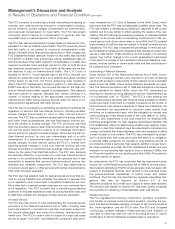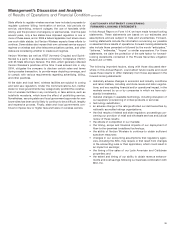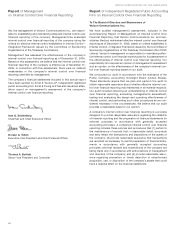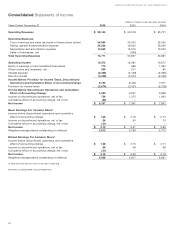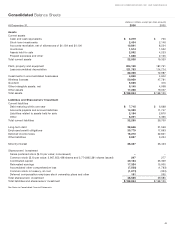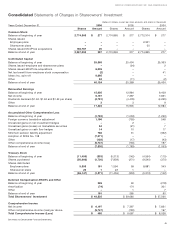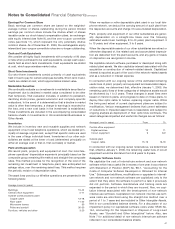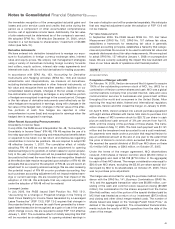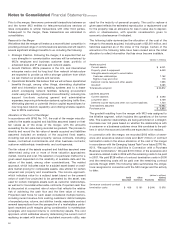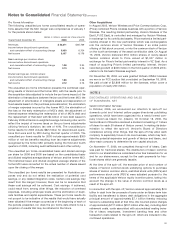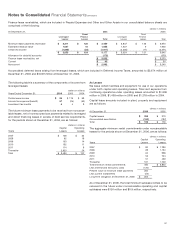Verizon Wireless 2006 Annual Report Download - page 49
Download and view the complete annual report
Please find page 49 of the 2006 Verizon Wireless annual report below. You can navigate through the pages in the report by either clicking on the pages listed below, or by using the keyword search tool below to find specific information within the annual report.
Notes to Consolidated Financial Statements continued
47
Earnings Per Common Share
Basic earnings per common share are based on the weighted-
average number of shares outstanding during the period. Diluted
earnings per common share include the dilutive effect of shares
issuable under our stock-based compensation plans, an exchange-
able equity interest (see Note 9), and the zero-coupon convertible
notes (see Note 11), which represent the only potentially dilutive
common shares. As of December 31, 2006, the exchangeable equity
interest and zero-coupon convertible notes are no longer outstanding.
Cash and Cash Equivalents
We consider all highly liquid investments with a maturity of 90 days
or less when purchased to be cash equivalents, except cash equiv-
alents held as short-term investments. Cash equivalents are stated
at cost, which approximates market value.
Short-Term Investments
Our short-term investments consist primarily of cash equivalents
held in trust to pay for certain employee benefits. Short-term invest-
ments are stated at cost, which approximates market value.
Marketable Securities
We continually evaluate our investments in marketable securities for
impairment due to declines in market value considered to be other
than temporary. That evaluation includes, in addition to persistent,
declining stock prices, general economic and company-specific
evaluations. In the event of a determination that a decline in market
value is other than temporary, a charge to earnings is recorded for
the loss, and a new cost basis in the investment is established.
These investments are included in the accompanying consolidated
balance sheets in Investments in Unconsolidated Businesses or
Other Assets.
Inventories
We include in inventory new and reusable supplies and network
equipment of our local telephone operations, which are stated prin-
cipally at average original cost, except that specific costs are used
in the case of large individual items. Inventories of our other sub-
sidiaries are stated at the lower of cost (determined principally on
either an average cost or first-in, first-out basis) or market.
Plant and Depreciation
We record plant, property and equipment at cost. Our local tele-
phone operations’ depreciation expense is principally based on the
composite group remaining life method and straight-line composite
rates. This method provides for the recognition of the cost of the
remaining net investment in telephone plant, less anticipated net
salvage value, over the remaining asset lives. This method requires
the periodic revision of depreciation rates.
The asset lives used by our Wireline operations are presented in the
following table:
Average Lives (in years)
Buildings 15-42
Central office equipment 5-11
Outside communications plant
Copper cable 13-18
Fiber cable 11-20
Microwave towers 30
Poles and conduit 30-50
Furniture, vehicles and other 3-20
When we replace or retire depreciable plant used in our local tele-
phone network, we deduct the carrying amount of such plant from
the respective accounts and charge it to accumulated depreciation.
Plant, property and equipment of our other subsidiaries are gener-
ally depreciated on a straight-line basis over the following
estimated useful lives: buildings, 8 to 40 years; plant equipment, 3
to 15 years; and other equipment, 3 to 5 years.
When the depreciable assets of our other subsidiaries are retired or
otherwise disposed of, the related cost and accumulated deprecia-
tion are deducted from the plant accounts, and any gains or losses
on disposition are recognized in income.
We capitalize network software purchased or developed along with
related plant assets. We also capitalize interest associated with the
acquisition or construction of network-related assets. Capitalized
interest is reported as part of the cost of the network-related assets
and as a reduction in interest expense.
In connection with our ongoing review of the estimated remaining
useful lives of plant, property and equipment and associated depre-
ciation rates, we determined that, effective January 1, 2005, the
remaining useful lives of three categories of telephone assets would
be shortened by 1 to 2 years. These changes in asset lives were
based on Verizon’s plans, and progress to date on those plans, to
deploy fiber optic cable to homes, replacing copper cable. While
the timing and extent of current deployment plans are subject to
modification, Verizon management believes that current estimates
of reductions in impacted asset lives is reasonable and subject to
ongoing analysis as deployment of fiber optic lines continues. The
asset categories impacted and useful life changes are as follows:
Average Lives (in years) From To
Central office equipment
Digital switches 12 11
Circuit equipment 9 8-9
Outside plant
Copper cable 15-19 13-18
In connection with our ongoing review noted above, we determined
that, effective January 1, 2006, the remaining useful lives of circuit
equipment would be shortened from 8-9 years to 8 years.
Computer Software Costs
We capitalize the cost of internal-use network and non-network
software which has a useful life in excess of one year in accordance
with Statement of Position (SOP) No. 98-1, “Accounting for the
Costs of Computer Software Developed or Obtained for Internal
Use.” Subsequent additions, modifications or upgrades to internal-
use network and non-network software are capitalized only to the
extent that they allow the software to perform a task it previously
did not perform. Software maintenance and training costs are
expensed in the period in which they are incurred. Also, we capi-
talize interest associated with the development of non-network
internal-use software. Capitalized non-network internal-use soft-
ware costs are amortized using the straight-line method over a
period of 1 to 7 years and are included in Other Intangible Assets,
Net in our consolidated balance sheets. For a discussion of our
impairment policy for capitalized software costs under SFAS No.
144, Accounting for the Impairment or Disposal of Long-Lived
Assets, see “Goodwill and Other Intangibles” below. Also, see
Note 7 for additional detail of non-network internal-use software
reflected in our consolidated balance sheets.


